|
|
|
|
|
|
|
|
|
|
|
|
|
|
|
|
(206BC - 220AD) Han Dynasty 2-handed steel double-edged swords (jian) in their scabbards, excavated and dated 2nd Century BC. At this time, during the 1st half of the Han Dynasty, steel swords were typically made from forged and folded steel (as per the steel swords of the Warring States Period). A new process of heat-treatment, the differential process, was also developed during this time. The technique of forge-welded/laminated construction was invented later, about 200 years after, by the 1st century AD.
The development of these original 2-handed steel swords occurred during mid-to-late Warring States Period (350 - 300 BC), as mentioned earlier. They went on to become a favourite of civilians and members of the Imperial Court during the early part of the Han Dynasty. For a look at another illustration, go to: http://chineseswords2.freewebspace.com/custom3.html
|
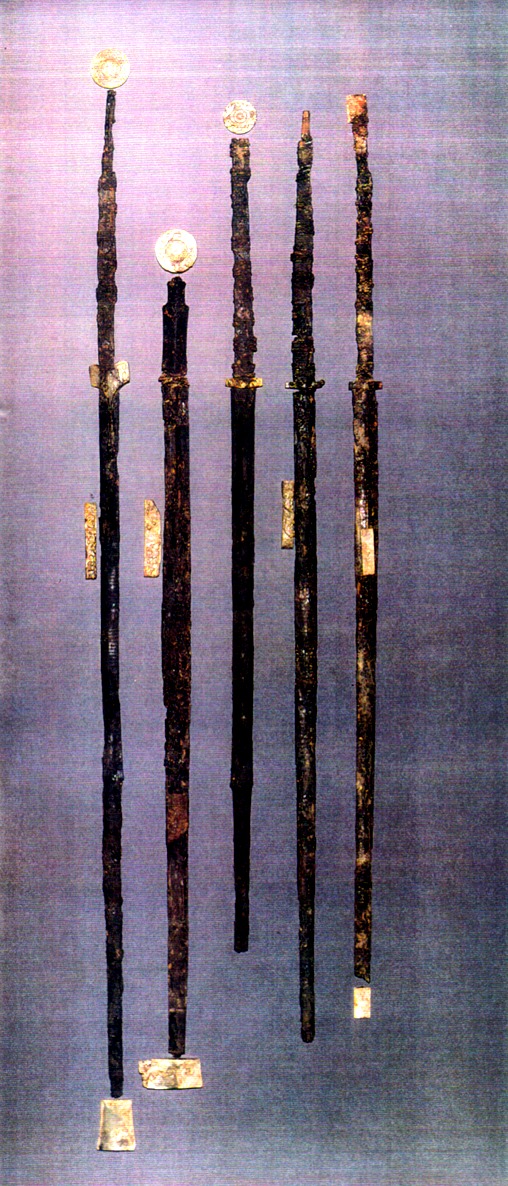 |
Below: The matching sets of jade fittings of some of the swords shown above. These jade fittings are standard mounts on jians dating from the Warring States Period to the first half of the Han Dynasty. Exquisitely carved with tigers, phoenixes, other types of animals and auspicious motifs, they reflect the highly-developed aesthetic taste of the Chinese during this period.
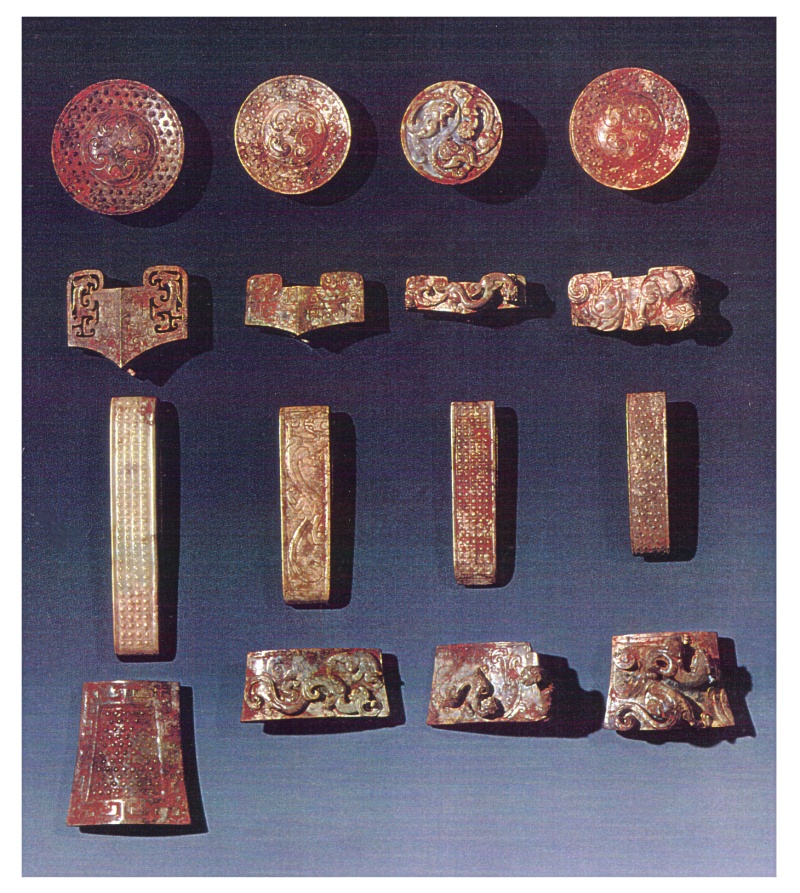
|
|
|
|
|
|

|
|
|
_______________________________________
Below: Early Han Dynasty single-edged bronze sword (dao) with a ring pommel. Notice the pronounced edge bevel plus ridged cross-section on this weapon, which constitute the ancestral prototype of the ridged cross-sections seen later in the steel swords of the Sui and Tang Dynasties. Click on the pic to see more.
This switch by the Chinese military from double-edged swords (jian) to single-edged swords (dao) during the Han Dynasty was prompted by the extensive use of Chinese cavalry in combat against proto-Mongol nomads. In mounted warfare, slashing/chopping actions were more important than thrusting. However, the jian remained and continued to be used throughout the various dynasties by civilians, and selectively by generals, who strapped on the jian as a symbol of their rank. It seems that there was, however, a resurgence in the use of the jian as a military weapon during the Song Dynasty.
By the later part of the Han Dynasty, steel had also completely replaced bronze as the metal of choice in the manufacture of swords and other edged-weapons.

|
|
|
Han Dynasty bronze ring pommel adorned with a dragon head motif (mouth open and facing left). The curvey patterned lines are gold inlay.
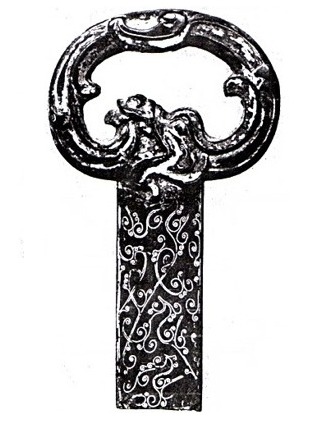
|
|
|
______________________________
Below: the 3 pics show the handle fittings of steel daos from the 4th - 5th centuries AD, excavated in Korea. Similar ones were excavated in China. It is clear that steel daos based on this Chinese design were made in Korea and Japan as well as being imported into these 2 countries. These fittings were made of bronze; some of the most exquisite ones, like the 2 below, come guilded with gold. The intricate patterns on these handles speak of meticulous craftsmanship.
These ring pommels are decorated with 2 dragons coiled around each other.
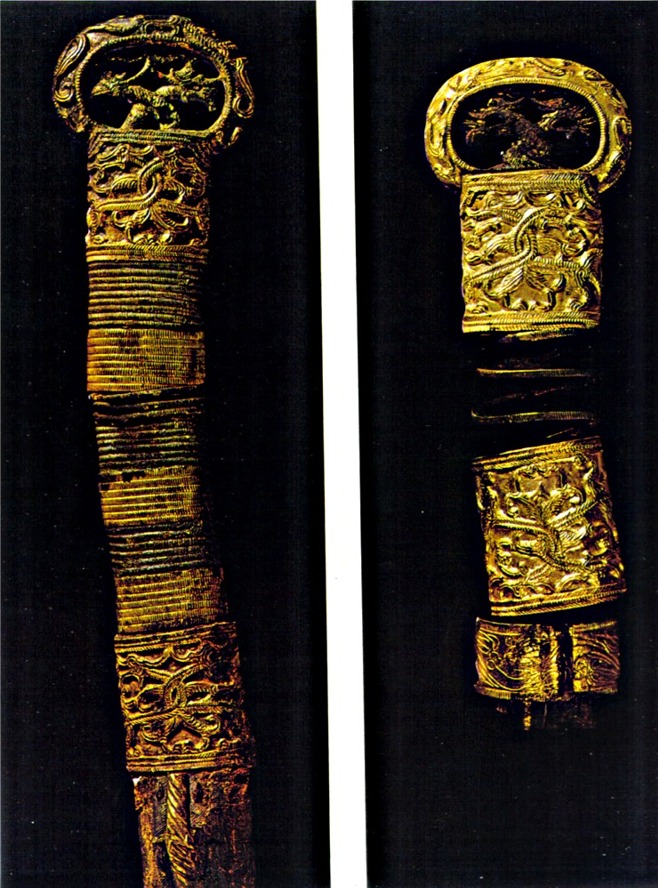
|
|
|
|
|
|
|
|
|
This ring pommel exhibits a single dragon motif. The bird symbols within the six-sided polygons represent the phoenix. Notice also the use of twisted metal wire to provide an abrasive surface for a firm hand grip.
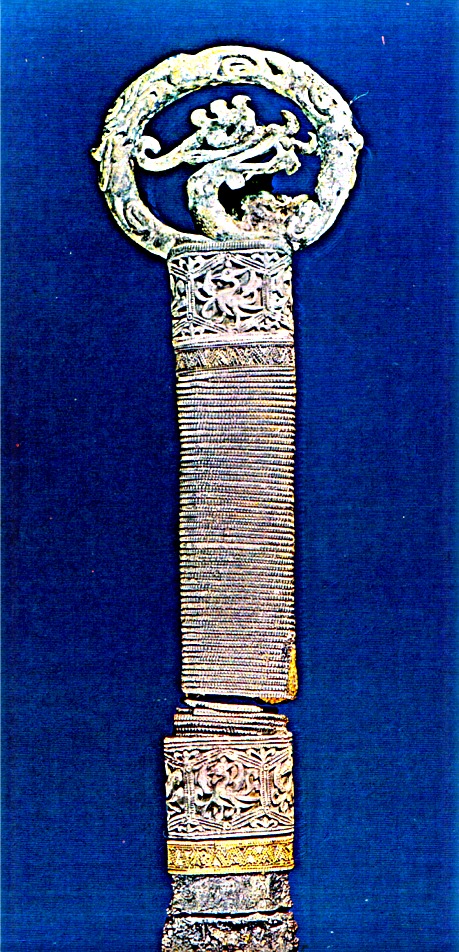
|
|
|
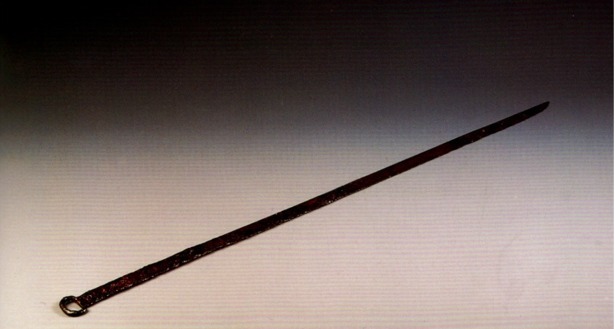
|
|
|
Above: Steel Dao of the Eastern Han Dynasty. It is 1.12 meters long, with a spine/back thickness of 1 centimeter and breadth 3 centimeters. The gold inlaid Chinese inscription actually states the year of manufacture (AD 112) and that the blade was forged from a process of "30 refinings". Steel blades at this time were typically forged and folded (resulting in the creation of multiple layers of steel), of forge-welded/laminated construction and differentially heat-treated.
Benefits of such techniques -- Forging and folding help to improve the quality and strength of the steel by minimizing impurities and spreading the carbon content evenly throughout the steel. The utilization of forge-welded/laminated construction where higher carbon steel (around 0.7% - 0.8% carbon) was used for the cutting edge ONLY and medium/lower carbon steels (ranging from 0.4% - 0.7% carbon) used for the spine or side-sandwiching plates, helps to create a blade with a harder cutting edge (for enhanced cutting performance) and a softer supporting backbone (for flexibility, to prevent breakage). The differential heat-treatment where ONLY the cutting edge portion and NOT the spine of the blade is heat-treated helps to enhance these features. Such advanced manufacturing techniques were to form the basis of Chinese blades for the next 2000 years and were to be transmitted later to Korea, Japan, Vietnam, Laos and Thailand. Click on the above pic to see another piece.
Below: Another Han Dynasty steel dao polished and restored by Shanxi Province Antique Sword Preservation Society and published online February 2008.

|
|
|
Another Steel Dao of the Han Dynasty. Note the corded wrapped grip and the scabbard slide on the scabbard.

|
|
|
|
|
|
Han Dynasty mural engraving of 3 warriors with their daos. Note the warrior on the left holding his weapon with a 2-handed grip.

|
|
|
|
|
|
|
|
|